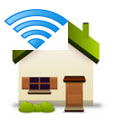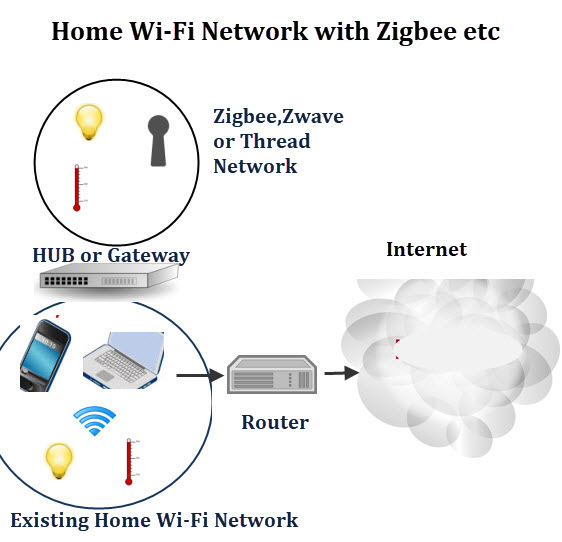 Today almost every home and small home office has a home network, and an Internet connection.
Today almost every home and small home office has a home network, and an Internet connection.
The current home network enables multiple devices e.g. PCs,tablets etc to connect to each other, and also to connect to the internet.
Today most home networks will use a mixture of Ethernet and Wi-fi wireless networking technology and the TCP/IP networking protocol.
Smart Home devices will connect either directly to the existing home network or else indirectly via a hub or gateway.( Zwave and Zigbee). See Home automation basics.
Today’s Home Networks- TCP/IP Basics
Current home networks that connect your tablet,PC and Smart phone to the Internet are based on the TCP/IP protocol.
Most homes will already have this network in place.
The following tutorial will help you understand, build, and extend a home TCP/IP network.
- Basic networking Course
- How to Set Up a Home Network
- How to Extend a Home Network
- Powerline Networking Guide -How To Setup HomePlug Adapters
- Home Wi-Fi Mesh Systems- Quick Overview
- How to Setup A Secure Wireless Home Network
- How to create a guest network
Home networks use TPC/IP and although you don’t need to be a TPC/IP expert you should at least understand the basics, particularly device addressing and address allocation.
You will also encounter network problems so being familiar with troubleshooting tools like the ping command will be of great benefit.
Home Automation Network Protocols – Z-Wave, Zigbee
Smart home devices are almost all wireless devices. The initial requirement of these devices was for low powered devices which meant that Wi-FI wireless technology that is used on TCP/IP based networks was not considered suitable.
Therefore the first home automation devices were developed to use Z-Wave or Zigbee wireless technologies.
The main advantages of these technologies is low power and they are not affected as much by the building layout giving them better coverage.
Because these technologies don’t use WI-FI or TCP/IP they don’t have an IP addresses.
This means that you cannot connect a Zigbee or Z-Wave device directly to a WI-FI or TCP/IP based network.
However to really be smart, devices should ideally be controllable from across the Internet.
Which in turn means that they will need to connect to TCP/ IP network.
Therefore many home automation networks will require some form of hub or gateway to connect them to the existing Wi-Fi or Wired network and will look like the one shown in the diagram below:

Devices using ZigBee and Zwave form their own network independent of the existing home Wi-Fi network ,but can be connected to the existing Wi-fi Network using a suitable hub or gateway.
Thread is a newer standard sponsored by Google and uses IP networking ( zwave and Zigbee don’t) but uses 6lowpan and not Wi-Fi.
See ZWave Basics and Zigbee Basics
Note:The industry has recently standardised on the Matter protocol which was standardised by the major smart home providers -Google, Apple and Amazon.
See- An Introduction to Matter
Smart devices will also have a variety of addresses depending on the protocol that they are using.
Zigbee and Z-Wave networks don’t have IP addresses but use their own addresses structure.
See Zwave addressing and Zigbee addressing
and the Smart hubs and Gateways guide
Note: The terms hub and Gateway are used interchangeably on smart home networks. See what is a Hub
Video- Smart Home Wireless Protocols
Very good but long video covering Zwave, Zigbee,thread, Wi-fi and Bluetooth
Connecting To The Internet
Almost all home networks will be connected to the Internet.
- Internet Connection and Access Methods
- Troubleshooting Home Network and Internet Connection Problems
- Internet Speeds Explained
Isolating the Smart Home Network
It is a good idea to isolate the network containing smart devices from the rest of the home network.
This can be done using VLANs see VLANS on Home Networks
Zigbee (Zwave)vs Wi-Fi
Zigbee(Zwave) are the preferred choice when the devices run on batteries due to the low power consumption.
Wi-fi is really the only choice when it comes to high bandwidth applications like video cameras.
Zigbee is also an excellent choice when you want local control.
This is because Zigbee devices will pair with any Zigbee coordinator, and so it is possible to use Zigbee2MQTT or Tasmota2Zigbee coordinator with home assistant or with a other home automation controllers rather than using the device manufacturer App.
As an example I use Tuya sensors,sockets and smoke alarms without using the Tuya cloud app.
I use them with both Zigbee to MQTT and home assistant and also using Tasmota to MQTT and my node-red smart home dashboard.
Future Networks and Summary
Many new smart devices are now using Wi_fi (e.g. Sonoff) and so can connect directly to the existing home Wi-Fi network.
However because of the early adoption of Z-wave and Zigbee, there are many device types that are currently only available for Z-wave or Zigbee.
A quick search on Amazon showed around 7,000 pages for Zigbee and 56,000 pages for Z-Wave.
It seems Z-Wave, because of its simple design dominates but there are many big players supporting Zigbee (e,g, phillips Hue) .
In addition there are also proprietary home automation networks and protocols like Mi Home (UK).
Personally I think Wi-Fi will dominate in the future with Z-Wave and Zigbee being used in special or legacy environments, and were low power and range are important.
With the emergence of matter devices the thread protocol thread is likely to become the most popular along with Wi-Fi.
Related Tutorials and Resources
- Setting Up and building a Home Network
- Windows File Sharing Basics
- Name resolution and DNS on Home Networks
Interesting but what are the higher level protocols? Wifi is just essentially wireless ethernet so what do the devices use over the connection? Text? HTTP? Proprietary stuff? What TCP or UDP port is used?
Most use http and run a mini web server. Others use MQTT. Generally the ones that run MQTT also support http. Tasmota is a good example. Have you seen this
https://stevessmarthomeguide.com/controlling-smart-home-devices/
Many smart home devices use Zigbee or Zwave in which case they are controlled using that prorocol.
It is possible to control Zigbee using MQTT with the Zigbee2MQTT bridge
https://stevessmarthomeguide.com/using-zigbee2mqtt-beginners-guide/
You can also bridge Zwave and Zigbee to http which is the way Zigbee and Zwave devices are controlled via a smart phone app or Alexa etc.
rgds
steve
Nice writeup. It would be good to augment this article with a discussion of MOCA adapters. If you have existing cable in the walls they’re more performant than powerline adapters.
Hi
I have mentioned them somewhere but obviously not in this post I will update it.
Tks
Rgds
Steve
This is a great website. It is truly different, in a very good way. Thanks for making your expertise freely available to others – and for doing so in a way that I find so easy to follow.
Thanks a bunch I feel fortunate to have run across your website. certainly bookmarking it. Thanks again